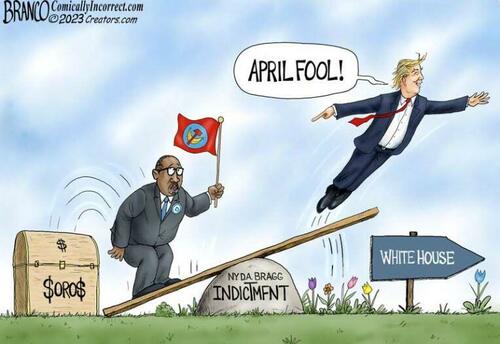Watch: Anthropology Prof Angered After Being Mocked For Denying Ability To Tell Gender From Human Bones
There is an interesting controversy that has erupted at the University of Pittsburgh after Dr. Gabby Yearwood, who teaches in both the anthropology and law schools, was asked by swimmer Riley Gaines if he could tell the gender of persons from skeletal remains.
He denied that that was possible despite the widely accepted ability to do so in his field. The answer may reflect the ongoing push in anthropology, discussed in an earlier blog column, to put an end to gender identifications. Some insist that anthropologists need to know how an ancient human may have chosen to identify themselves.
Yearwood reportedly was asked the question by Gaines, who achieved national notoriety in opposing the inclusion of transgender athletes like the University of Pennsylvania’s Lia Thomas in women competitions.
Like J.K. Rowling who has raised concerns over the threat to feminist gains from some transgender policies, Gaines is now ostracized and often prevented from speaking at events.
To its credit, Pittsburgh refused to yield to demands to bar Gaines and others from speaking on campus. This controversy appears to have resulted during the event that many sought cancel.
Gaines asked Yearwood, “If you were to dig up two humans one hundred years from now, both man and woman, could you tell the difference, strictly off of bones?”
According to Fox, Yearwood answered “No!” and then took umbrage after the room erupted in laughter.
He reportedly reminded them that he was “the expert in the room” and asked “Have any of you been to anthropological sites? Have any of you studied biological anthropology? I’m just saying, I’ve got over 150 years of data, I’m just curious as to why I’m being laughed at. I have a PhD!”
The videos posted on Twitter only show the first part of that exchange.
Gaines reportedly responded that “Every single rational person knows the answer: men have narrower hips, their skulls are different, they have an extra rib, their femurs are longer, their jaws are different.”
When @Riley_Gaines_ asked University of Pittsburgh professor Gabby Yearwood if an archeologist could differentiate between two sets of bones as male and female, Professor Yearwood. who calls himself the “expert in the room,” answers “no” to which the entire audience laughed. pic.twitter.com/Ecxs1NMDTr
— Independent Women’s Forum (@IWF) March 30, 2023
One expert is quoted by the College Fix as disagreeing with Yearwood though offering a correction also to one of Gaines’ statements.
San José State University archaeology Professor Elizabeth Weiss said determining the sex of skeletal remains “is a critical skill in forensics and any diminishing of this skill will negatively impact criminal investigations, denying the victims and their families justice.” She added that “Riley Gaines is correct on many traits, but males do not have an extra rib. This myth comes from the Adam and Eve story.”
Schools like Boston University note that
“Sex is typically determined by the morphology (shape) of the pelvis or skull and long bone measurements. ‘However, many of the areas on the skeleton that are used for sex estimation may be missing or damaged due to trauma, poor preservation, animal scavenging and nature of the incident (explosive). Therefore, it is important to examine other areas of the skeleton that preserve well and are potentially sexually dimorphic (show differences between females and males),’ explained corresponding author Sean Tallman, PhD, RPA, assistant professor of anatomy and neurobiology.”
In fairness to Yearwood, experts have said that determining gender occurs along a spectrum of analysis because some women may easily be mistaken for men. Indeed, there was research showing an overcounting of male skeletons in research by famed anthropologist Aleš Hrdlička, who helped found the modern study of human bones and served as the first curator of physical anthropology at the U.S. National Museum.
This controversy is part of a wider debate unfolding on our campuses.
University of Kansas Associate Professor Jennifer Raff argued in a paper, “Origin: A Genetic History of the Americas,” that there are “no neat divisions between physically or genetically ‘male’ or ‘female’ individuals.” Her best selling book has been featured on various news outlets like MSNBC.
Raff is not alone. Graduate students like Emma Palladino have objected that “the archaeologists who find your bones one day will assign you the same gender as you had at birth, so regardless of whether you transition, you can’t escape your assigned sex.”
Professors Elizabeth DiGangi of Binghamton University and Jonathan Bethard of the University of South Florida have also challenged the use of racial classifications in a study, objecting that “[a]ncestry estimation contributes to white supremacy.” The authors write that “we use critical race theory to interrogate the approaches utilized to estimate ancestry to include a critique of the continued use of morphoscopic traits, and we assert that the practice of ancestry estimation contributes to white supremacy.”
It is not clear if this movement influenced Yearwood’s answer. He has been a leader in calling for “critical engagement” and “activist research” to change the field of anthropology.
Dr. Yearwood’s bio shows that he is widely published and known in his field.
“Gabby M.H. Yearwood is a Senior Lecturer in the Department of Anthropology and Managing Faculty Director for the Center for Civil Rights and Racial Justice in the Law School at the University Pittsburgh. He is a socio-cultural anthropologist earning his Ph.D from the University of Texas at Austin in Anthropology focusing in Black Diaspora Studies and Masculinity. His research interests include the social constructions of race and racism, masculinity, gender, sex, Black Feminist and Black Queer theory, anthropology of sport and Black Diaspora. Dr. Yearwood holds a secondary appointment with the Gender, Sexuality and Women’s Studies Program at Pitt. Dr. Yearwood is also a teaching member of the Pitt Prison Education Project.”
Among his courses is “Activist Anthropology” the description of which reads:
“[T]his course will teach students that ‘critical engagement brought about by activist research is both necessary and productive. Such research can contribute to transforming the discipline by addressing knowledge production and working to decolonize our research process. Rather than seeking to avoid or resolve the tensions inherent in anthropological research on human rights, activist research draws them to the fore, making them a productive part of the process. Finally, activist research allows us to merge cultural critique with political action to produce knowledge that is empirically grounded, theoretically valuable, and ethically viable.’ (Speed 2006). This course will teach students both the importance and value of conducting research that moves outside of the “ivory tower” of academia. “[A]ctivist scholars work in dialogue, collaboration, alliance with people who are struggling to better their lives; activist scholarship embodies a responsibility for results that these “allies” can recognize as their own, value in their own terms, and use as they see fit.” (Hale 2008) This course will explore major conceptual work on the role and ethical responsibility of anthropological research and social justice issues.”
Tyler Durden
Sat, 04/01/2023 – 17:30
via ZeroHedge News https://ift.tt/umIlqWn Tyler Durden














